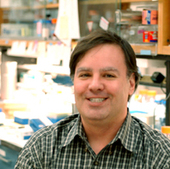I had just finished my last Rice science piece when I found this, which shook me to my shoes. (No, not this, which is what some think today’s Rice headline should be.)
Right now 45% of all deaths involve some sort of fibrous growth in our bodies. Among these killers are atherosclerosis, asthma, cirrhosis, scleroderma and pulmonary fibrosis. Doctors can only manage such diseases. They can’t cure them, and certainly can’t prevent them.
But now, thanks to biochemistry professor Richard Gomer (right) and faculty fellow Darrell Pilling, this might change.
The substance is serum amyloid P, SAP for short. It’s a naturally
occurring blood protein. It regulates the healing of wounds by
inhibiting the activity of fibrocytes, which make
the collagen used to heal wounds.
Gomer and Pilling have already conducted some animal studies with
SAP, and found it actually prevented fibrotic scar tissue from
developing in the heart or lungs of mice that were susceptible to this. The technology has been licensed to Promedior, an outfit which raised its first capital tranche in 2005. Promedior, in turn, was a spin-off from Trellis Bioscience of San Francisco.
This is the kind of thing you win Nobel prizes for.
Gomer says the
story started from a chance meeting at a 2001 conference in Houston,
and that the basic work of isolating the protein took just a few
months. Gomer himself had been working with an amoeba called
Dictyostelium and had also written some papers on astrophysics (he was
originally a physics major at Pomona College) but dropped both to
pursue SAP.
This will take some time to play out, but the potential here is
absolutely enormous. We’re talking about a preventative for nearly half
of all deaths. That compares well to the impact of statins, like
simvastatin and Lipitor, which now help prevent heart disease and
stroke arising from high cholesterol.
My only problem with this story is the slow pace of Promedior in the market. Why are they in Malvern, Pennsylvania? Why haven’t they gone beyond a Series A financing? Why is their Web site so primitive?
We’re building a mystery here.













What’s wrong with Malvern? It’s suburban Philadelphia. You are close to Penn and Drexel and within 2 hours of Columbia and Johns Hopkins in terms of talent base. You have access to plenty of Philadelphia and New York money. Where would be a better location?
What’s wrong with Malvern? It’s suburban Philadelphia. You are close to Penn and Drexel and within 2 hours of Columbia and Johns Hopkins in terms of talent base. You have access to plenty of Philadelphia and New York money. Where would be a better location?